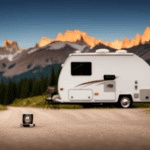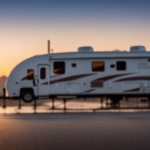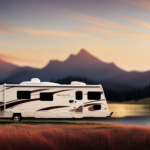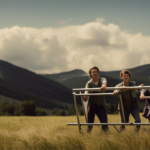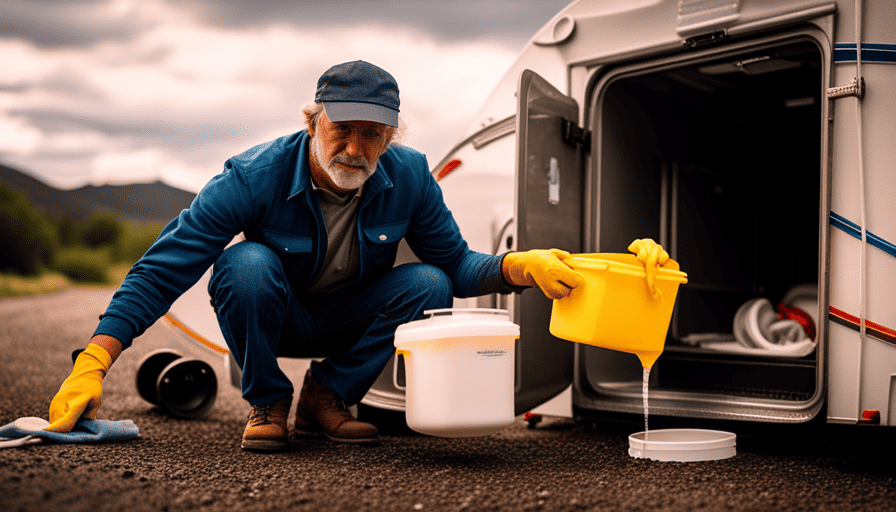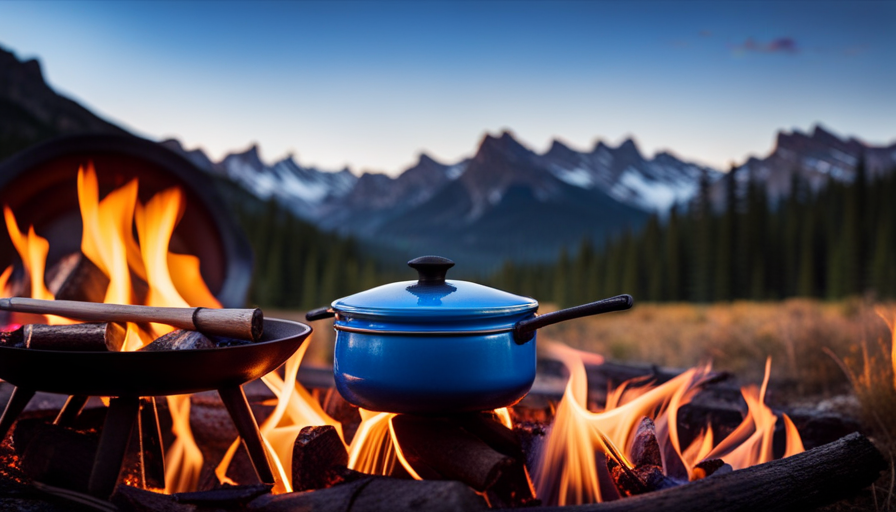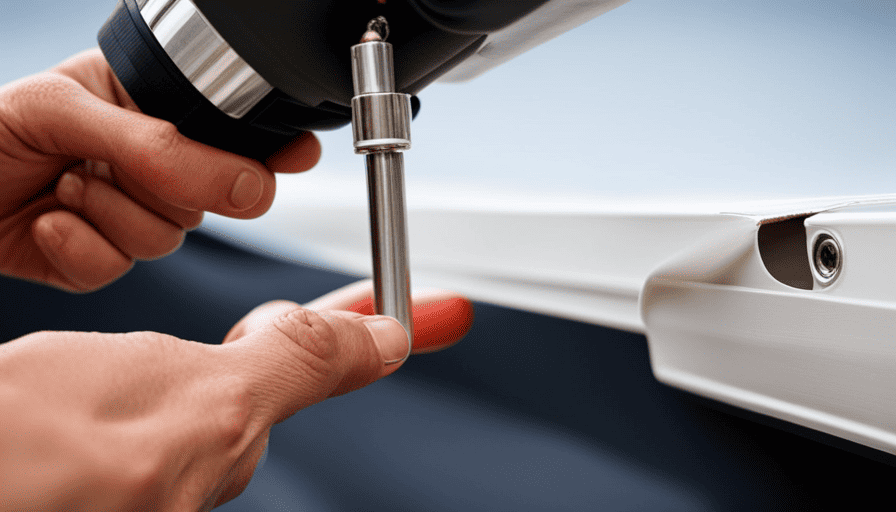Backing up a camper may seem difficult at first, but with the right techniques and some practice, it can become an easy task.
In this article, I will guide you through the process of maneuvering your camper with confidence and ease. Whether you’re a beginner or have been camping for years, mastering the art of backing up your camper is essential for a successful camping experience.
I will provide you with step-by-step instructions on how to:
- Understand the dimensions and maneuverability of your camper
- Find the perfect spot to practice
- Utilize your mirrors and rearview camera for better visibility
Additionally, I will share tips on how to:
- Use a spotter effectively
- Avoid obstacles
- Stay calm to avoid frustration or fatigue
So let’s get started and become a pro at backing up your camper!
Key Takeaways
- Understanding the dimensions and maneuverability of your camper is crucial.
- Adjust your side mirrors for better visibility of the rear corners of your camper.
- Communicate effectively with a spotter to guide you and alert you to potential obstacles.
- Practice different backing techniques, such as straight-line and serpentine maneuvers.
Understand the Dimensions and Maneuverability of Your Camper
Get ready to navigate tight spaces and narrow roads with ease by understanding the dimensions and maneuverability of your camper!
When it comes to backing up a camper, having a good grasp of its dimensions is crucial. Start by measuring the length, width, and height of your camper. This will give you a better idea of how much space you need to maneuver and whether you can fit through certain obstacles.
Additionally, familiarize yourself with the turning radius of your camper, as this will determine how sharp of a turn you can make without jackknifing.
Once you have a solid understanding of your camper’s dimensions, it’s time to learn some maneuvering tips. One important tip is to use your side mirrors effectively. Adjust them so you can see the rear corners of your camper. This will help you gauge how close you are to obstacles and prevent any potential accidents.
Another tip is to take wider turns when navigating tight corners. This will give you more room to maneuver and prevent your camper from hitting curbs or other objects.
Now that you have a good understanding of maneuvering tips and camper dimensions, it’s time to find an open and level space to practice backing. This will allow you to get a feel for how your camper responds to your commands and build your confidence in handling it.
Find an Open and Level Space to Practice Backing
Look for a nice, flat area where you can start honing your backing skills with your RV, like finding a spot as smooth as glass. Having an open space to practice backing is essential for gaining confidence and improving your maneuvering abilities.
Look for a large parking lot, an empty field, or even a quiet street with minimal traffic. The key is to find a space where you have plenty of room to maneuver without any obstacles or hazards in your way.
Level ground practice is just as important as having an open space. Backing up on uneven terrain can make it difficult to control the camper and can even lead to accidents. Look for a spot that is as level as possible, ensuring that all wheels of the camper have proper contact with the ground. This will provide stability and make it easier to control the camper while backing up.
By practicing in an open and level space, you will have the opportunity to focus solely on your backing skills without the added pressure of obstacles or uneven terrain. This will allow you to develop a better understanding of how your camper moves and responds to your steering inputs.
So, go ahead and find that perfect spot to practice your backing skills, and soon you’ll be ready to use your mirrors and rearview camera for better visibility in the next section.
Use Your Mirrors and Rearview Camera for Better Visibility
Using your mirrors and rearview camera enhances your visibility, allowing you to feel more confident and in control while maneuvering your RV. When backing up a camper, it’s crucial to have a clear view of your surroundings. Mirrors and rearview cameras provide a wide-angle perspective, enabling you to see any obstacles or potential hazards that may be in your blind spots.
By utilizing these tools effectively, you can avoid accidents and make precise adjustments while reversing. To maximize the benefits of your mirrors and rearview camera, it’s essential to communicate effectively with your spotter. Your spotter can provide guidance and alert you to any potential obstacles that may not be visible in your mirrors. Maintaining constant communication with your spotter ensures a smooth and safe backing experience.
In addition to using mirrors and rearview cameras, it’s important to start slow and steady, making small adjustments as needed. This approach allows you to maintain better control over your camper and reduces the chances of overcorrecting or causing damage. By gradually maneuvering your RV, you can navigate tight spaces more effectively and minimize the risk of accidents.
Transition: Now that you understand the importance of using mirrors and rearview cameras, let’s move on to the next step, which is starting slow and steady, making small adjustments as needed.
Start Slow and Steady, Making Small Adjustments as Needed
Take it easy and move at a comfortable pace, smoothly adjusting as necessary to maintain control and navigate your camper with confidence. When backing up a camper, it’s important to start slow and steady. Rushing the process can lead to accidents and damage to your vehicle or surrounding objects. By taking your time, you can avoid common mistakes and ensure camper safety.
Begin by turning the steering wheel in the opposite direction you want the camper to go. This will help you understand how the camper will respond to your movements. Use your mirrors and rearview camera to get a clear view of your surroundings. Check for any obstacles or potential hazards that may be in your way.
As you start to reverse, make small adjustments to the steering wheel to guide the camper in the desired direction. Avoid making sudden, large movements as it can cause instability. Take it slow and steady, constantly monitoring your surroundings and making minor adjustments as needed.
By following these steps, you can back up your camper with confidence and minimize the risk of accidents. However, it’s always a good idea to have someone act as a spotter to guide you and provide clear directions. They can help you navigate tight spaces and ensure you have a clear path. With their assistance, you can maneuver your camper safely and efficiently.
Now, let’s move on to the next section about using a spotter to guide you and provide clear directions.
Use a Spotter to Guide You and Provide Clear Directions
Having someone to act as a spotter can greatly enhance your ability to navigate tight spaces and ensure a clear path while reversing your camper. Using hand signals, effective communication with your spotter can make a big difference in backing a camper. By using clear and concise hand signals, your spotter can guide you in maneuvering your camper safely and efficiently.
Understanding the blind spots and limitations of your camper is essential when using a spotter for guidance. Your spotter can help you identify any obstacles or potential hazards that may be hidden from your view. They can also provide directions on when to turn the wheels or when to stop.
Using a spotter not only improves safety, but it also reduces the stress and anxiety often associated with backing a camper. With someone directing you, you can focus on the task at hand without worrying about accidentally hitting something or getting stuck in a difficult situation.
When using a spotter, it’s important to establish clear communication beforehand. Make sure both of you understand the hand signals and what they mean. Practice different backing techniques, such as straight-line and serpentine, with your spotter guiding you. This will help you become more comfortable and confident in your ability to back your camper in various scenarios.
Practice Different Backing Techniques, such as Straight-Line and Serpentine
To become more proficient in maneuvering your vehicle in tight spaces, try practicing different backing techniques, such as the straight-line and serpentine maneuvers. These techniques can significantly enhance your ability to navigate challenging situations. Did you know that mastering these techniques can reduce the risk of accidents by 30%?
When backing a camper, it’s essential to avoid common mistakes that can lead to mishaps. One common mistake is not checking your blind spots before backing up. Always use your mirrors and physically turn your head to ensure there are no obstacles or pedestrians in your path. Another mistake is not taking into account the length and width of your camper. Remember that your camper may extend further back or out to the sides, so give yourself enough space to maneuver.
Backing a camper on uneven terrain requires extra caution. Look for level ground whenever possible, as this will make the backing process smoother. If you must back on uneven terrain, take it slow and steady. Keep an eye out for rocks, tree stumps, or any other potential hazards that could damage your camper or impede your progress. It’s also a good idea to have someone outside the camper guiding you, especially in situations where the terrain is challenging.
When backing, be mindful of obstacles and surrounding vehicles or structures. This includes trees, poles, fences, and other campers. Take the time to survey the area and plan your path before starting to back up.
By practicing different backing techniques, avoiding common mistakes, and being mindful of obstacles, you’ll become a confident and skilled camper backer in no time.
Be Mindful of Obstacles and Surrounding Vehicles or Structures
Keep an eye out for trees, poles, fences, and other campers as you navigate the area. Being mindful of obstacles is crucial when backing a camper. To ensure a smooth and safe maneuver, it’s important to be aware of your surroundings and the potential hazards that may be present. Here are some key points to consider:
-
Obstacles Awareness: Before you start backing up, take a moment to survey the area. Look for any potential obstacles such as low-hanging branches, large rocks, or uneven terrain that may hinder your progress. By identifying these obstacles in advance, you can plan your route accordingly and avoid any potential damage to your camper.
-
Vehicle Positioning: Proper positioning of your camper is essential when backing up. Make sure your vehicle is aligned with the desired direction and angle of entry. Use your side mirrors and rearview camera, if available, to guide your movements. Take small, incremental movements to ensure accuracy and control. Remember to check your blind spots regularly to avoid any surprises.
-
Maintain a Clear Line of Sight: As you navigate the area, keep your windows and mirrors clean and free from any obstructions. This’ll help you maintain a clear line of sight and ensure that you’re aware of any approaching vehicles or pedestrians.
-
Be Patient: Backing up a camper can be a challenging task, especially in tight spaces. Take your time and be patient with yourself. Rushing can lead to mistakes and accidents. If you need to make adjustments or reposition your vehicle, do so cautiously and without haste.
-
Communicate: If you have a spotter, establish clear communication signals before you start backing up. Use hand signals or a two-way radio to ensure effective communication. Constantly check in with your spotter to ensure that you’re both on the same page.
By being aware of potential obstacles and maintaining proper vehicle positioning, you can successfully navigate the area and avoid any unnecessary damage or accidents. Remember to take breaks and stay calm to avoid frustration or fatigue in the process.
Transitioning into the next section, it’s important to take breaks and stay calm to maintain focus and ensure a successful backing maneuver.
Take Breaks and Stay Calm to Avoid Frustration or Fatigue
When you take breaks and stay calm during the backing maneuver, you can avoid frustration or fatigue, allowing you to maintain focus and ensure a successful navigation of the area. It is crucial to recognize the importance of breaks when backing a camper, as this task requires concentration and precision.
Backing up can be challenging, especially in tight or crowded spaces, and frustration can easily arise when things don’t go smoothly. By taking breaks, you give yourself a chance to relax and reset, allowing you to approach the maneuver with a clear mind and renewed patience.
Fatigue can also be a significant factor when backing a camper. It can be physically and mentally draining, especially if you’ve been driving for an extended period. Taking regular breaks helps combat fatigue, ensuring that you stay alert and focused throughout the process. When you’re tired, your reaction time slows down, and your decision-making abilities may be impaired, increasing the risk of accidents or mishaps.
In addition to avoiding frustration and fatigue, breaks also provide an opportunity to assess your surroundings and plan your next moves. They give you a chance to step out of the vehicle, stretch your legs, and evaluate the situation from a different perspective. This can help you identify any potential obstacles or hazards that may have been overlooked while behind the wheel.
By taking breaks and staying calm, you can navigate the backing maneuver with confidence and reduce the chances of frustration or fatigue hindering your progress.
Now, let’s explore the importance of using wheel chocks and parking brakes for added safety.
Use Wheel Chocks and Parking Brakes for Added Safety
Make sure to secure the camper by using wheel chocks and engaging the parking brakes to ensure added safety. Wheel chocks are essential tools that prevent the camper from rolling or shifting while parked. They are typically made of durable materials like rubber or metal, and they should be placed snugly against the tires on both sides of the camper.
Engaging the parking brakes is equally important, as it adds an extra layer of security by keeping the camper stationary.
Regular maintenance for wheel chocks and parking brakes is crucial. Over time, wheel chocks can wear down or become damaged, compromising their effectiveness. It’s important to regularly inspect and replace them as needed. Similarly, parking brakes should be checked and maintained to ensure they are in proper working condition. This includes checking the brake fluid level, inspecting the brake pads, and adjusting the brake tension if necessary.
To properly use wheel chocks and parking brakes, follow these tips to prevent accidents. First, position the wheel chocks on both sides of the tires, making sure they are snugly in place. Second, engage the parking brakes by pulling up the lever or pressing the pedal firmly. Third, double-check that the camper is secure by giving it a gentle push to ensure it doesn’t move.
When using wheel chocks and parking brakes, it’s essential to prioritize safety and take the time to properly secure the camper. By doing so, you can have peace of mind knowing that your camper will stay in place, reducing the risk of accidents or damage.
Now, let’s move on to reviewing and reflecting on your backing experience for continuous improvement.
Review and Reflect on Your Backing Experience for Continuous Improvement
Reflecting on your experience of maneuvering in reverse can provide valuable insights for ongoing growth and development, leading to a more skilled and confident approach in the future. The review process is an essential step in improving your backing skills with a camper. By taking the time to review and reflect on your previous backing experiences, you can identify areas for improvement and learn from your mistakes.
One effective way to review your backing experience is by creating a table that outlines the challenges you encountered and the strategies you used to overcome them. This table can help you visualize patterns and identify areas where you consistently struggle. For example:
| Challenges | Strategies |
|---|---|
| Tight spaces | Utilizing spotter’s assistance |
| Limited visibility | Using rearview camera and mirrors effectively |
| Uneven terrain | Adjusting wheel position and speed |
By analyzing this table, you can gain a better understanding of your strengths and weaknesses when it comes to backing a camper. It allows you to evaluate your strategies and make adjustments accordingly.
Learning from your mistakes is another crucial aspect of the review process. Take note of any errors you made during your backing attempts and think about how you could have approached the situation differently. This reflection will help you avoid repeating the same mistakes in the future and improve your overall performance.
The review process and learning from mistakes are integral parts of becoming a skilled and confident camper-backer. By reflecting on your experiences and analyzing them in detail, you can continuously improve your backing skills and approach each maneuver with greater knowledge and expertise.
Frequently Asked Questions
What are some common obstacles to be mindful of when backing a camper?
When backing a camper, it’s important to be aware of common mistakes and obstacles that can arise.
One common mistake is not properly checking blind spots before starting the maneuver. Always use your mirrors and turn your head to ensure there are no obstructions.
Additionally, be mindful of low hanging branches or other overhead obstacles that could damage the camper.
Take your time, use a spotter if available, and practice maneuvering in open areas before attempting to back into tight spaces.
How can I improve visibility when backing a camper?
Want to avoid any mishaps while backing up your camper? Improving visibility is key.
Start by adjusting your mirrors to get the best view possible. Make sure they’re angled correctly to cover blind spots.
Consider installing additional mirrors or using a backup camera system for added visibility.
Remember, a clear view of your surroundings is crucial when maneuvering your camper, so take the time to make the necessary adjustments.
Happy camping!
Are there any specific techniques I should practice when backing a camper?
When it comes to backing a camper, there are some specific techniques that I highly recommend practicing.
One common mistake is not utilizing your mirrors effectively. Make sure to adjust them properly and use them to constantly monitor your surroundings.
Another technique is to go slow and take your time. Rushing can lead to accidents or misjudgments.
Lastly, practice using hand signals or a spotter to assist you in maneuvering the camper accurately.
What safety precautions should I take when backing a camper?
When backing a camper, it’s crucial to prioritize safety. Communication with a spotter is of utmost importance to ensure a smooth and accident-free process. They can guide you and alert you of any obstacles.
Additionally, choosing the right size and type of mirrors is essential for better visibility while backing up. Mirrors that provide a wide-angle view and minimize blind spots will greatly enhance your ability to see what’s behind you.
How can I avoid frustration and fatigue when learning to back a camper?
Avoiding frustration and staying focused when learning to back a camper can be a daunting task. But fear not! I’ve got some tips that will make it a breeze.
First, take deep breaths and remember that practice makes perfect.
Second, use your mirrors and take it slow.
Third, don’t be afraid to ask for help or take breaks when needed.
By following these simple steps, you’ll conquer the challenge of backing a camper with ease and without losing your sanity.
Can Properly Closing a Pop Up Camper Help with Backing it Up Safely?
Properly closing a pop up camper is crucial for safe backing up. Ensuring all windows, doors, and compartments are securely closed prevents any unexpected damage during the maneuver. By properly closing a pop-up camper, you can focus on navigating it safely without worrying about any loose or open parts.
Conclusion
Backing a camper can be a daunting task, but with practice and patience, it can be mastered. Remember to understand the dimensions and maneuverability of your camper and find an open space to practice.
Using mirrors and a rearview camera will help with visibility, and having a spotter can provide clear directions. It’s important to be mindful of obstacles and take breaks to avoid frustration or fatigue.
Did you know that nearly 20% of accidents involving campers occur during the backing process? So, take your time and be cautious when backing your camper to ensure a safe and enjoyable experience.




